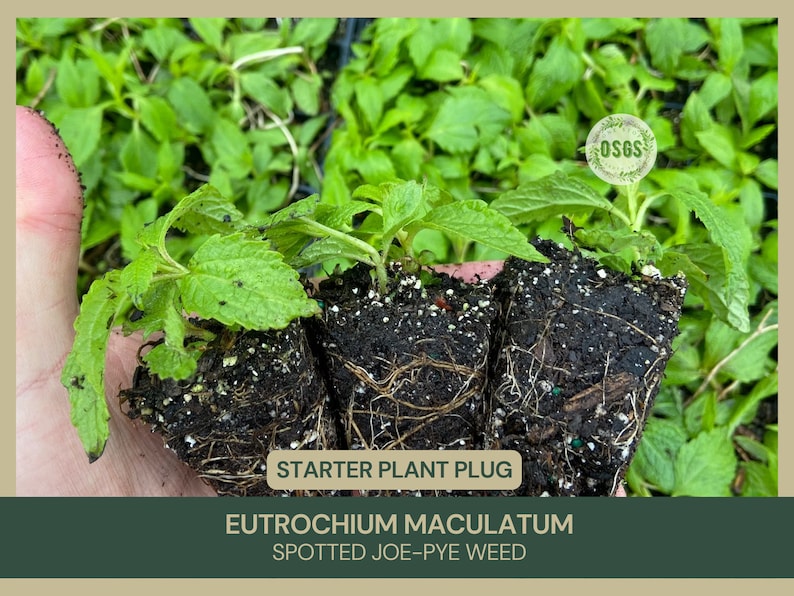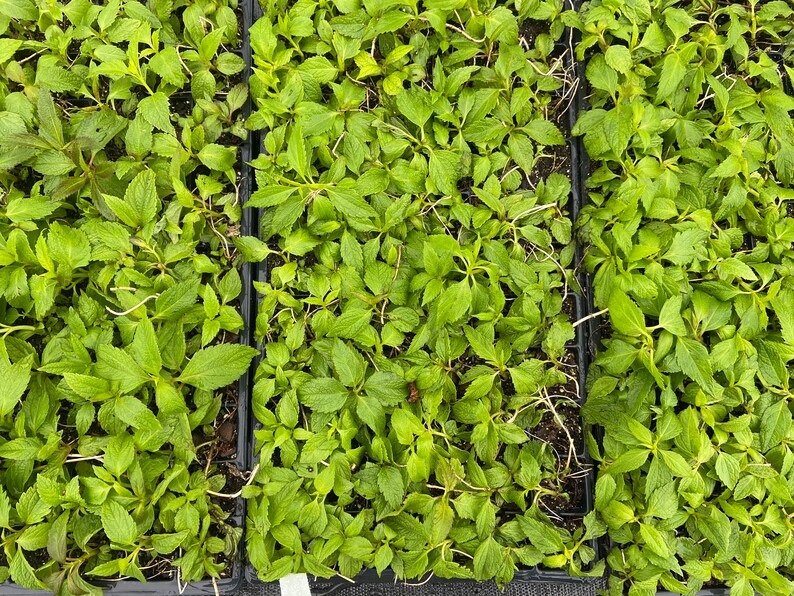
Eutrochium maculatum
Common name: Spotted Joe-pye Weed
Embracing the Majesty of Spotted Joe-Pye Weed: A Comprehensive Gardening Guide
Eutrochium maculatum, known as Spotted Joe-Pye Weed, is a robust and striking perennial, famous for its tall stature, purple-pink flowers, and spotted stems. Ideal for adding height and color to the back of garden borders or naturalized areas.
Known for attracting butterflies and pollinators with its nectar-rich flowers.
Flourishes in moist environments, making it perfect for rain gardens or waterside planting.
Blooms in late summer, providing late-season interest in the garden.
Plant Care
Eutrochium maculatum, formerly known as Eupatorium maculatum and commonly known as spotted Joe-Pye weed, is a striking perennial native to North America, known for its tall stature and large, fluffy, mauve-pink flower clusters. This plant is highly appreciated for its ability to attract butterflies and its visual impact in naturalistic garden settings. Here’s a guide to caring for Eutrochium maculatum:
Sunlight Requirements: Prefers full sun to light shade. Full sun encourages the most robust growth and prolific flowering, but it can also tolerate light shade, particularly in hotter climates where some afternoon shade can help prevent scorching.
Watering Needs: While Eutrochium maculatum is drought-tolerant once established, it thrives in moist conditions. It's particularly well-suited for wetter areas of the garden or along pond edges where it can receive ample moisture. Regular watering is recommended, especially in dry conditions, to maintain its lush appearance.
Soil Type and pH Preferences: Thrives in rich, moist soils and is adaptable to a variety of soil conditions, though it prefers slightly acidic to neutral pH. Adding organic matter to the soil can help improve its structure and moisture retention capabilities.
Temperature and Climate Requirements: Hardy in USDA Zones 3-8, spotted Joe-Pye weed can withstand a wide range of temperatures and is suitable for many different garden settings. It is robust and resilient, capable of handling both cold winters and hot summers.
Pruning and Maintenance: Requires minimal maintenance once established. Deadheading the spent flowers can promote additional blooming and help maintain a tidy appearance. Cutting the plant back to the ground after the flowering period in late fall or early spring can help encourage vigorous growth and maintain plant health.
Propagation: Can be propagated by seed, division, or stem cuttings. Seeds can be sown directly in the garden in fall. Division in the spring is recommended every few years to rejuvenate older clumps and control their spread in the garden.
Eutrochium maculatum is an excellent choice for adding height and color to the back of a border or as part of a native or wildlife garden. Its dramatic flower clusters are not only beautiful but also serve as an important nectar source for butterflies and other pollinators during the late summer months. This plant's presence in the garden can help create a dynamic and ecologically supportive landscape.
Planting and Propagation
Planting Eutrochium maculatum, commonly known as Spotted Joe-Pye Weed, introduces a striking and robust perennial to your garden, known for its tall stature and fluffy, pinkish-purple flower clusters that bloom from late summer into fall. This native plant is especially valuable for its ability to attract butterflies, bees, and other pollinators while adding architectural height to garden beds and borders. Spotted Joe-Pye Weed thrives in moist environments, making it an ideal selection for rain gardens, along pond margins, or in wet meadows. Here’s how to plant and care for Eutrochium maculatum to enrich your garden’s biodiversity and visual appeal.
When to Plant
Best Time: Early spring or fall are optimal times for planting, allowing the plant to establish in cooler temperatures and moist soil conditions.
Zone Considerations: Hardy in USDA zones 4-8, Eutrochium maculatum is adaptable to a range of climates and thrives in moist to wet environments.
Selecting a Site
Sunlight: Prefers full sun to light shade. Full sun encourages the most vigorous growth and optimal flowering, but it can tolerate light shade, particularly in hotter climates.
Soil: Thrives in moist, fertile soil. It is particularly well-suited for areas that retain moisture but also requires good drainage to prevent root rot.
Planting Steps
Soil Preparation: Amend the soil with organic matter to improve fertility and moisture retention. This is particularly important if the soil is sandy or lacks organic content.
Spacing: Space plants about 2 to 3 feet apart to allow for mature growth and proper air circulation.
Planting Depth: Dig a hole that is as deep as the root ball and twice as wide. Place the plant in the hole, ensuring the top of the root ball is level with the soil surface. Backfill with soil, gently firming it down.
Ongoing Care
Watering: Water regularly to keep the soil consistently moist, particularly during dry spells. Eutrochium maculatum is not drought-tolerant and performs best with regular moisture.
Fertilizing: Apply a balanced, slow-release fertilizer in the spring to support robust growth and abundant flowering. Avoid over-fertilizing, which can lead to weak growth and fewer flowers.
Pruning: Deadheading the spent flowers may encourage additional blooming and prevent self-seeding. Cut back the plants to the ground in late fall after they die back, or leave the stalks over winter to provide habitat for wildlife and then cut back in early spring.
Planting Eutrochium maculatum adds not only a visually impactful element to your garden but also serves as an excellent nectar source for pollinators late in the season when food sources can be scarce. Its tall, stately form and vibrant flowers make it a focal point in any garden setting, particularly effective in naturalistic or wild garden designs.
Pests and Diseases
Spotted Joe-Pye Weed is generally robust but monitor for common issues.
Pests: Generally, Spotted Joe-Pye Weed is pest-resistant but watch for occasional problems with aphids or leaf miners. Manage pests as needed.
Diseases: It’s resistant to most diseases but can be susceptible to powdery mildew in crowded conditions with poor air circulation. Ensure plants are well-spaced and in a location with good airflow.
Feeding and Fertilizing
Initial Feeding: Apply a balanced slow-release fertilizer early in the spring as new growth starts. A 10-10-10 NPK ratio is suitable for providing the necessary nutrients for initial growth.
Soil Preparation: Enrich the planting area with well-decomposed compost to enhance soil fertility and structure. This step is crucial as Eutrochium maculatum thrives in rich, moist soil.
Supplemental Feeding: If the plant is in less fertile soil, consider a mid-season feeding with a water-soluble fertilizer to support vigorous growth and abundant flowering.
Avoid Over-Fertilization: Excessive application of fertilizer, especially nitrogen, can lead to lush foliage at the expense of flowers and can also make the plants more susceptible to pests and diseases.
pH Adjustment: This plant prefers a soil pH of slightly acidic to neutral (pH 6.0-7.0). Testing and adjusting the soil pH can improve nutrient availability and plant health.
Maintain Moisture: Eutrochium maculatum requires consistently moist soil to flourish. Mulching helps retain soil moisture, control weeds, and keep root temperatures stable, benefiting overall plant vigor and bloom quality.
Seasonal Care
Seasonal adjustments in care are key for the health and vitality of your Spotted Joe-Pye Weed.
In fall, the plant's foliage may turn a pleasing reddish color.
Cut back the stems to the ground in late fall or early spring.
Mulch lightly in fall to protect the roots in colder regions.
Plant Uses
Spotted Joe-Pye Weed is versatile in garden design and serves various ecological roles.
Excellent for naturalized areas, wet meadows, and alongside ponds or streams.
Provides height and structure to perennial borders and butterfly gardens.
Its late blooming period makes it valuable for extending garden color.
Varieties and Cultivars
Eutrochium maculatum, formerly known as Eupatorium maculatum, is commonly referred to as spotted Joe-Pye weed. It is a striking perennial native to North America, particularly valued for its tall stature, showy flower clusters, and the ability to thrive in moist, fertile soils. It's an excellent plant for adding vertical interest to gardens and naturalized areas and is highly effective in attracting pollinators such as butterflies and bees.
Eutrochium maculatum
Appearance: This plant typically grows to 4-7 feet in height, featuring sturdy, purple-spotted stems and whorled leaves. In late summer to early fall, it produces dense, dome-shaped clusters of tiny, mauve-pink flowers.
Habitat Preferences: Prefers full sun to light shade and moist to wet soil conditions. It's ideal for rain gardens, along pond edges, or in moist meadows.
Ecological Benefits: The flowers are a magnet for pollinators, including bees, butterflies, and other beneficial insects. Additionally, it can help stabilize soil in wetland areas.
Here are some notable cultivars of Eutrochium maculatum that gardeners might consider:
'Gateway': This cultivar is shorter than the species, usually reaching about 4 to 5 feet tall, making it more suitable for smaller garden spaces. It boasts large, purplish-pink flower heads and is known for its robust growth and attractiveness to butterflies.
'Bartered Bride': Features pure white flower clusters that provide a striking contrast against the typically green and purple hues of the species. It reaches similar heights to 'Gateway' and adds a bright, light element to garden designs.
'Glenda': Distinguished by darker, more intense purple flowers and stems, 'Glenda' offers a deeper color variation and maintains the typical robust form of the species.
'Phantom': This shorter cultivar, around 3 to 4 feet tall, is ideal for smaller areas without sacrificing the visual impact of the traditional Joe-Pye weed. It produces deep pink flowers and has a compact growth habit.
'Red Dwarf': As suggested by its name, 'Red Dwarf' is a more compact version of the species, with a height of about 3 feet. It features a rich, reddish-purple stem and pink flowers, perfect for smaller gardens or as a front-of-border plant.
Eutrochium maculatum and its cultivars are not only beautiful but also provide significant ecological benefits, making them excellent choices for gardeners looking to create pollinator-friendly spaces or manage wet areas of their landscape effectively. Their tall, striking appearance adds drama and height to garden designs, while their late-season blooming provides color and interest when many other plants are beginning to fade.

Growing Tips and Tricks
A few additional tips will help you successfully grow and maintain Spotted Joe-Pye Weed.
Thrives in wet conditions; consider planting near a water feature or in a rain garden.
Staking may be necessary for taller varieties in windy locations.
Deadheading can promote a second, though smaller, bloom in the fall.
Troubleshooting Common Problems
Quickly addressing common issues will ensure the health and beauty of your plant.
Yellowing leaves may indicate too dry conditions; increase watering frequency.
If the plant becomes leggy, it might need more sun.
Ensure good drainage in the soil to prevent root rot in overly wet conditions.










